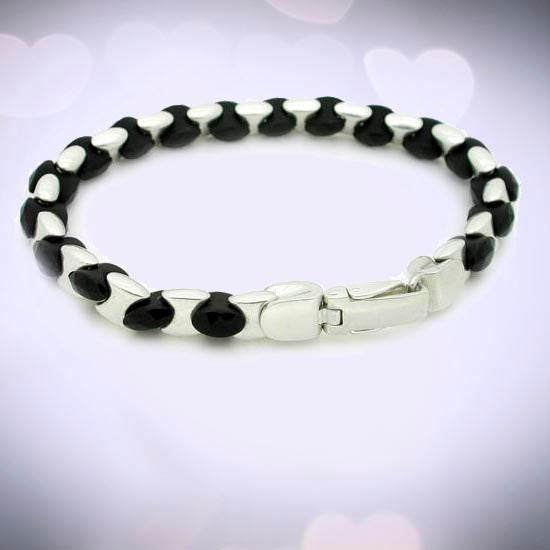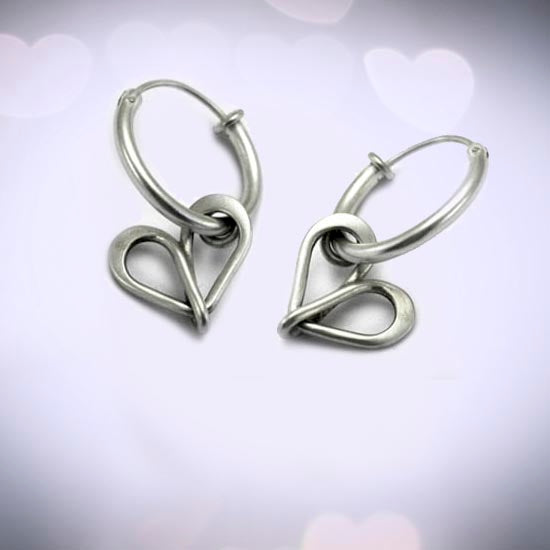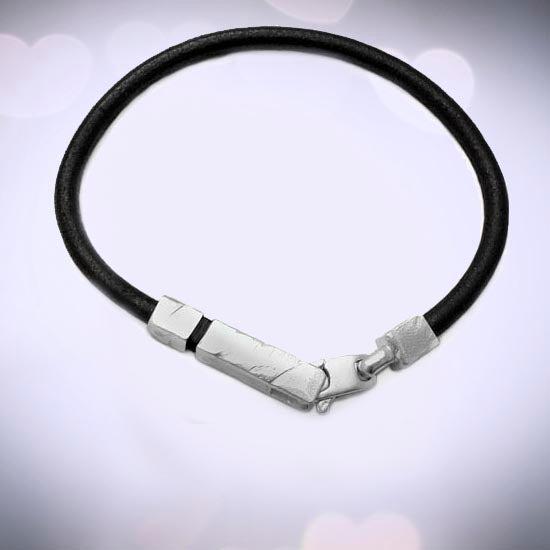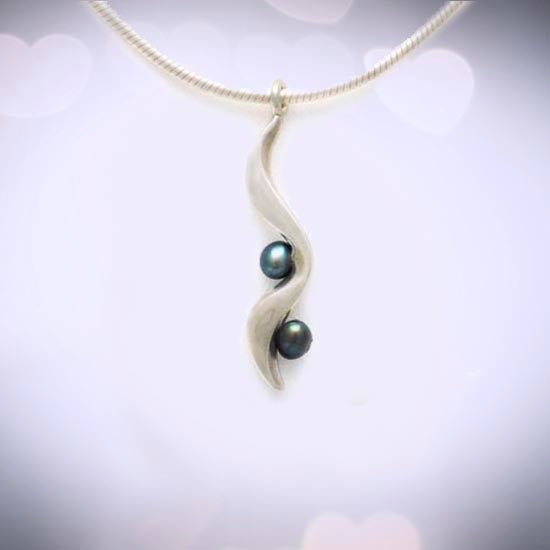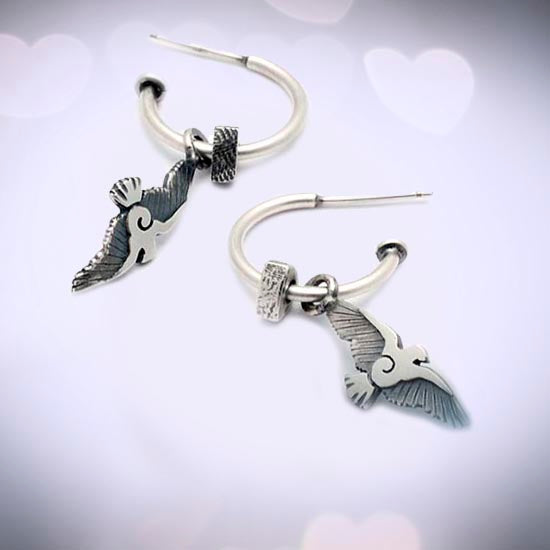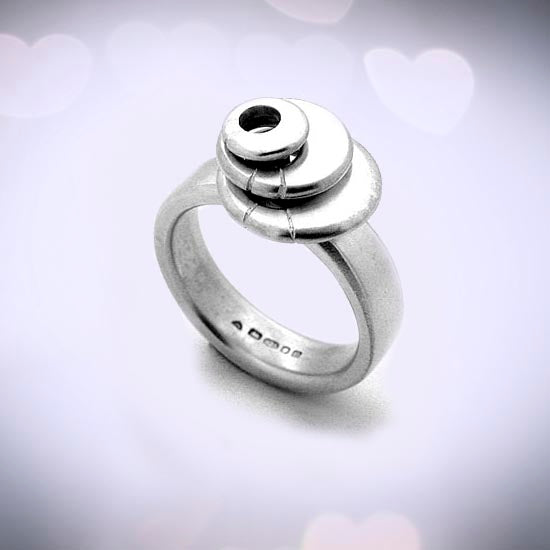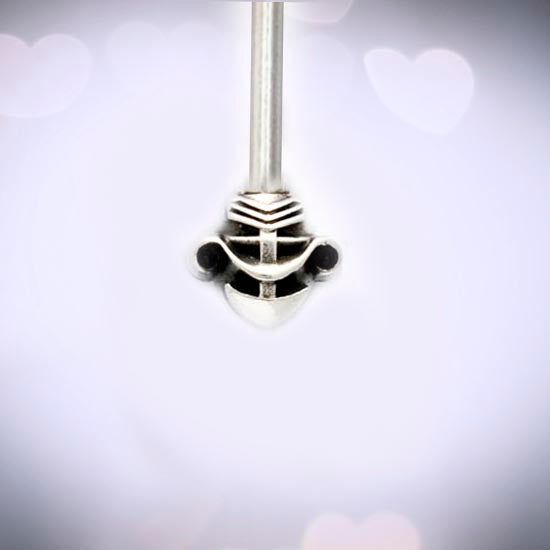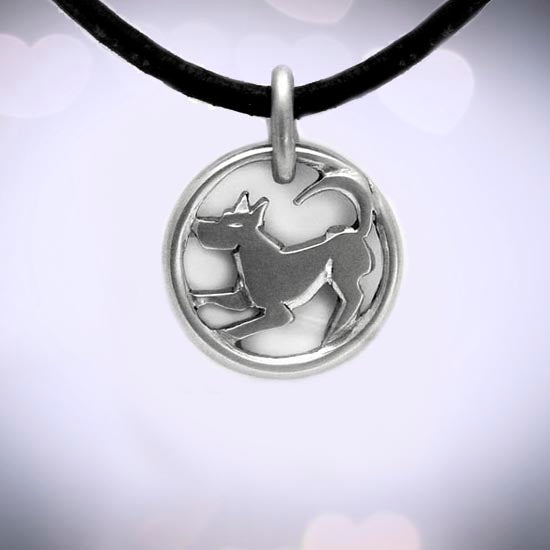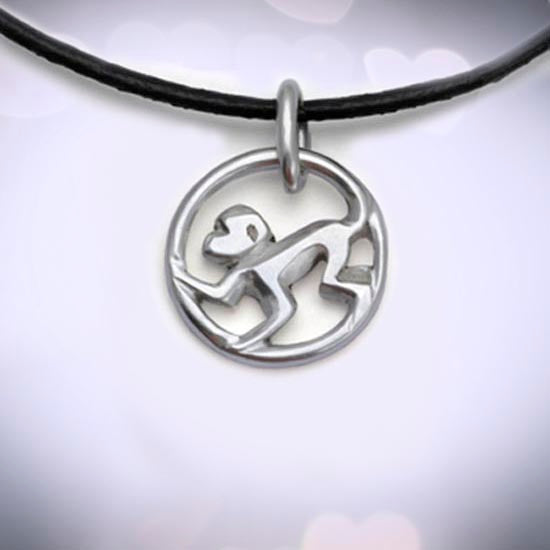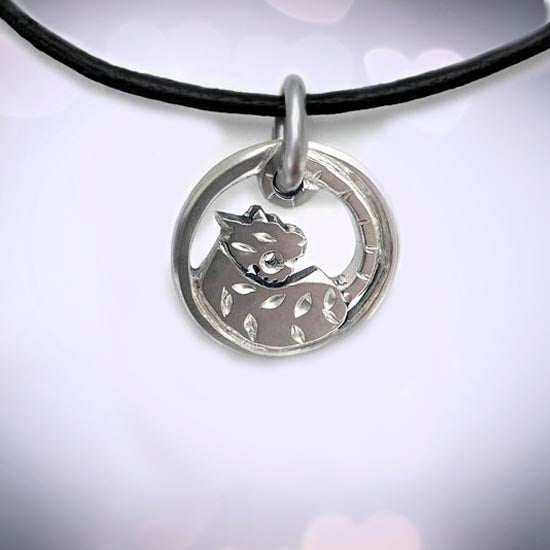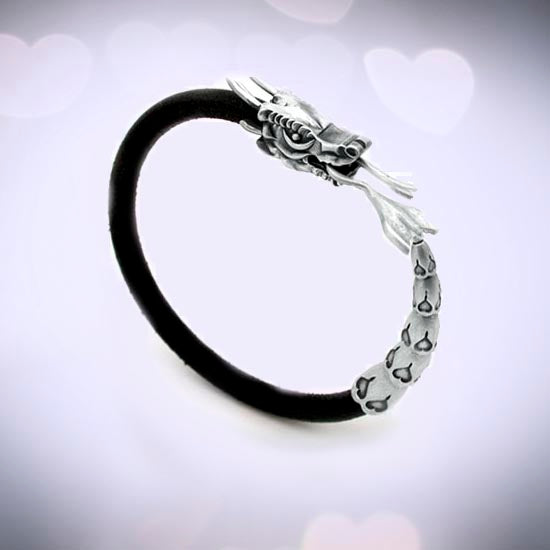
Some background information on the properties and qualities of silver, gold and platinum.
Silver info
Silver has been revered by countless civilizations for its innate beauty and intrinsic value. It is nearly white in colour, lustrous, soft and very flexible.
Used to make jewellery since ancient times it is now an essential component of modern life. Its unique properties make it one of the worlds most versatile and indispensable metals and it is utilised in an amazing array of areas from industrial to photographic purposes. This wonder metal acts as a biocide, killing bacteria, mildew and mould without harming people or the environment. Silver is used in textiles by clothing manufacturers to kill bacteria and keep clothes odour free, whilst bandage makers integrate silver into their products to stop the growth of germs in deep wounds.
More silver has been mined and used since the late 1700's than in all prior centuries combined, with almost 70% being a by-product of gold, copper, lead, and zinc mining whilst approx 20% of the world’s silver supply is from recycled materials, primarily, used photographic materials.
Classed as a noble or precious metal, silver is plastic (meaning it can be worked without rupture), malleable (it permits plastic deformation by compression hammering, rolling, and extrusion), and ductile (it permits plastic elongation without fracturing, as in wire drawing) and it is these properties, along side its ability to take and retain a stunning surface finish, that make it perfect for jewellery manufacture.
Silver is too soft in its pure form to be used for jewellery and is mixed (alloyed) with other metals to make it more durable.
Sterling silver, made of 92.5% pure silver and 7.5% mix of other metals such as copper and zinc, is now the standard in many countries including the UK and has been since the 14th century.
Tarnish
Perhaps this metal's most remarkable attribute is the way it ages. Sterling silver jewellery that is worn continually often develops a lovely patina, a kind of glow combined with darkened areas. It tends to oxidize easily and rapidly, reacting with hydrogen sulfide (H2S) in the air to form silver sulfide (Ag2S). This chemical reaction, known as tarnish, alters the natural colour of silver to a yellowish brass colour. The greater the amount of tarnish the darker the piece will go, eventually becoming black in colour. Silver will tarnish relatively quickly when it comes in contact with sulphur-containing compounds. These include food, especially eggs, mayonnaise, onions, fruit juices, tomatoes, vinegar, ketchup, salt, salty foods, butter, mustard, and tomato sauces. Other commonly found culprits are; rubber bands, latex gloves, wool, some plastics and paints, and fossil fuels. The rate of tarnish increases with the relative increase in humidity and rise in atmospheric temperature. Under such conditions, these substances interact, the atmospheric gas diffusing inward through the developing film, which causes the thickness of the layer of tarnish to grow. This chemical reaction can also be caused by reactions with sweat, hairsprays, deodorants, perfumes and soaps. Stress and diet also appear to have an affect due to the release of toxins through the pores.
The only form of sterling silver that will not tarnish is a plated form such as rhodium plated.
If you like the look, leave it alone. If you prefer a bright and shiny look, clean your pieces regularly or use polish to restore the jewellery to its original appearance. Make sure to dry your piece fully as moisture will exacerbate the tarnishing procedure.
A clean, soft polishing cloth will take care of your sterling silver whilst wearing your jewellery often helps prevent tarnish on the larger exposed surfaces. The simple practices of keeping your silver in an air tight container when not in use will reduce the amount of time you spend caring for your treasure.
Gold Info
The word gold derives from the Old English word 'gelo' meaning yellow and its rarity is such that it is estimated that all the gold in the world that has ever been refined would form a single cube 20 m (66 ft) a side.
Used to mark and celebrate notable occassions and achievements gold represents the highest attainments in life; 1st place, Golden Wedding Anniversaries, Golden Globes etc, whilst portraying affluence and luxury.
Gold and jewellery are almost synonymous in people’s minds because of its over 6,000 year use for this purpose. An ancient symbolic connection with the sun, derived from its unique bright yellow colour when in a pure form, combined with its ability to take and retain a long-lasting lustre have made it the metal of the Gods for many ancient civilizations and prized for centuries. Chemically inactive when pure, it is almost incorruptible and will not oxidize in air or rust in water.
Gold is the most malleable and ductile of all metals a single gram of gold can be beaten into a sheet of one square meter, or an ounce into 300 square feet, whilst gold leaf can be made thin enough to become translucent. The transmitted light appears greenish blue, because gold strongly reflects yellow and red.
Gold in its pure state is too soft for practical purposes but is easily alloyed with other metals giving it greater durability whilst allowing it to retain its desirable qualities to a great extent. An alloy is a new metal mixture that's created by combining two or more different metals. The proportion of pure metal within the alloy will define the carat (the measurement for gold purity) of the metal and the number stamped when assayed:
100 % pure, marked 999, is classed as 24 carat gold
91.7 % pure, marked 917, is classed as 22 carat gold
75 % pure, marked 750, is classed as 18 carat gold
58.3 % pure, marked 583, is classed as 14 carat gold
37.5% pure, marked 375, is classed as 9 carat gold
The word ‘carat’ comes from ‘carob’; carob seeds were originally used to balance scales in Oriental bazaars.
The type of alloy used will also determine the colour and strength of colour of the gold. The lower the carat of the gold, the higher the percentage of alloy and therefore the paler the yellow colour of the gold or the stronger the alternative colour, as the bright yellow colour of the pure gold becomes increasingly diluted.
Gold can therefore be made in various alternative colours
White Gold can be created by using nickel to create a white (or grey) colour, although this can cause dermatitis or skin problems in people who are sensitive to nickel. Many cheaper, imported, white gold jewellery items are made using this alloy, we do not use it.
The alternative to this, and the one we do use, is a Palladium alloy. Related to platinum, it is more expensive than nickel, but is less likely to cause allergic reactions and exudes a superior colour.
Rose & Pink Golds are created by adding Copper, whilst adding silver to gold creates Greenish shades.
Platinum info
Platinum is a simply beautiful, incredibly ductile and malleable metal. It is so rare that if all the platinum in the world were poured into an Olympic swimming pool it would barely cover your ankles and is actually 30 times rarer than gold.
All our gold designs are available in Platinum.
We are happy to adapt silver designs, though we recommend a scaling down in weight. Platinum is much denser metal, at over twice the weight of silver, and considerably greater in cost per gram. It also visually looks ‘heavier’, so a silver design directly translated will not only be vastly more expensive but may also appear bulky.
Platinum's density and weight make it more durable than other jewellery metals. A 15 cm (six-inch) cube of platinum weighs 165 lbs (75 kg), the same as an average man.
All precious metals will scratch but when platinum is scratched the metal is merely displaced and very little metal is lost, which means it maintains its volume and value over the years.
Platinum in its pure state is actually very soft. It cannot be used for jewellery in this form and is therefore alloyed in order to give it hardness. Not all Platinum jewellery available from around the world is the same high quality or purity and can be made using inferior alloys which can make the metal porous or brittle. Tested and Hallmarked by the London Assay Office, all our Platinum jewellery is 95% pure platinum, the UK standard, using high quality alloys and as such it does not fade or tarnish.
This high purity makes it hypoallergenic and therefore ideal for those with sensitive skin.
This also means you are getting more of the precious metal for your money compared to gold which, for example, at 18ct is only 75% pure.
A Platinum piece will weigh approximately 1.6 times that of an 18 carat gold piece and it is these differences in purity, density and greater gram price that account for the higher cost of platinum jewellery whilst it is widely recognised that platinum jewellery manufacture usually requires a higher level of craftsmanship.
The look of Platinum states glamour and prestige, whilst the glorious white lustre of the metal, reflects the true brilliance of diamonds and thus provides the best setting for precious jewels.
Recycling:
We are fervent believers in recycling and are pleased to offer you the option of recycling old, unwanted or tired jewellery. There are generally 3 options available (but not necessarily all possible depending on the condition and quality of the item.
- Pieces can be slightly reworked to freshen them up, alter their appearance or simply be mended. You may wish the surface to be refinished or altered by various means, such as hammering or removing a surface texture for example, or the length of an item altered etc.
- The piece can be dismantled and reassembled into other items, eg a necklace shortened and the extra length converted to earrings etc
- The whole piece melted down and the metal, metal value and/ or stones put towards a brand new design, either from one of our ranges or a specially commissioned piece.
We will be happy to advise you on possibilities.
Please check out our rejuvenation service for more info.
Hallmarking
The UK hallmark is an official mark stamped on jewellery showing that its quality conforms to legal standards.
Our work is tested and hallmarked externally by the London Assay Office, so you can
always be confident that the jewellery you are purchasing is as advertised.
The UK hallmark that you see on our work consists of the following format:

1 2 3 4 5
1. Makers Mark - Annika Rutlin's makers mark is a triangle with the initials AR
2. Metal Mark - Emblem representing the tupe of metal. In this example the Lion represents Sterling Silver.
3. The Millesimal Fineness Mark - This is the number of parts per thousand of pure metal in the alloy. In this example the ("% represents 92.5% pure silver which equates to Sterling Silver.
4. Assay Office Mark – This represents the Assay Office at which the piece was tested and marked. We use the London Assay Office symbolized by a lion’s head.
5. Date Mark – representing the year in which the item was tested and hallmarked.
Set out below are the different metal marks used for the different metal carats in the British Hallmark.

The UK has Four Assay Offices represented by the following marks:

We use the London Assay Office and so you will see the lion head mark on our work.
For more information on British Hallmarking please visit: www.thegoldsmiths.co.uk/assayoffice


